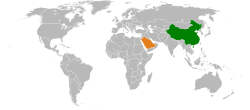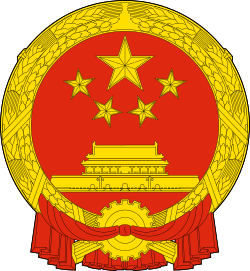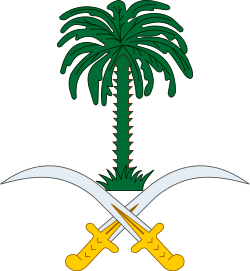China–Saudi Arabia relations
 |
|
China |
Saudi Arabia |
|---|---|
China–Saudi Arabia relations refers to the current and historical bilateral relationship between the People's Republic of China and the Kingdom of Saudi Arabia. The first Sino-Saudi official meeting took place in Oman in November 1985, following several years of heightened contact between the two countries.[1] The two governments established official diplomatic relations in July 1990.[2] Prior to the 1990s, bilateral relations between Saudi Arabia and the People's Republic of China (PRC) did not exist. In 1975, Saudi Arabia refused to recognize the PRC as a country, despite the PRC's desire to establish relations and acceptance of Saudi Arabian policies.[3] At present, it is said that "oil is the backbone of the relationship." [4] China and Saudi Arabia are strategic allies.
Establishing relations
Zheng He's Treasure voyages sent some men to Mecca and Medina.
As of 1989, Saudi Arabia was the only Arab country that still had not established Diplomatic ties with the People's Republic of China (although Saudi Arabia did maintain diplomatic relations with Taiwan).[5] After the Tiananmen Square protests of 1989 occurred in Beijing in June of that year, Saudi Arabian government relations with the PRC were upgraded. Despite the event, Saudi Arabia did not provide any criticism of the event. In fact, in August 1989, the Saudi Arabian Foreign Ministry official presented his credentials to the PRC's foreign minister. Less than a year later in July 1990, Prince Bandar bin Sultan, Saudi Arabia's ambassador to the United States paid a visit to Beijing with an agreement to establish diplomatic relations.[6] A few days later, diplomatic relations were established in Riyadh.[7] At this point, Saudi Arabia ended over forty years of diplomatic ties with Taiwan.[8]
Taiwan–Saudi Arabia relations
After World War II, the Republic of China (Taiwan) maintained diplomatic relations with only a few Middle Eastern countries, one of which was Saudi Arabia. The Hui Muslim General Ma Bufang was appointed as the first Republic of China ambassador to Saudi Arabia. Ma Chengxiang and Ma Bufang settled in Saudi Arabia. This was for two reasons. The first reason was largely out of "economic necessity," as Saudi Arabia was the largest supplier of oil to Taiwan, with Taiwan's state-run Chinese Petroleum Company importing about 40% of its oil annually from Saudi Arabia.[9] Because Taiwan was so reliant on Saudi Arabia's oil supplies, Taiwan put a significant amount of effort into maintaining relations. The second reason for Taiwan's ROC government warm policy towards Saudi Arabia is because since 1949, Saudi Arabia was an influential countries that recognized ROC as only China, even after ROC lost its seat in the UN Security Council in 1971. Citing respect for Islamic religion was another. [10] Ma Bufang and his son Ma Jiyuan established a Chinese Hui Muslim community in Saudi Arabia'a Hejaz region.
Relations between Taiwan and Saudi Arabia began around 1965 and were initially based on an agricultural relationship. As a way to demonstrate rice cultivation, Taiwan sent agricultural missions to Saudi Arabia. Then, in 1973, the two countries signed an agricultural cooperation agreement, in which Taiwan provided Saudi Arabia with a number of assistance programs, including irrigation, mechanized cultivation, soil, meteorology, crop rotation, and fishing technology. In 1978, Taiwan also began providing technical assistance in the field of health care. Taiwan has even provided Saudi Arabia with a number of doctors and nurses.[11]
Taiwan has also provided significant technical assistance to Saudi Arabia. In 1973, Taiwan's largest heavy construction company, Ret-Ser Engineering Agency (RSEA), began working on the 110-kilometer Mecca to Hawiya highway in Saudi Arabia. This led to other large projects, including the $100.4 million Shaar highway (夏爾降坡道路), the construction of an industrial park and sewage system, offshore and onshore work in the Saudi Naval Expansion Program, and housing for the King Abd al-Aziz Military Academy and King Khalid Military City. As of 1984, RSEA's projects in Taiwan amounted to a total dollar value of $1.3 billion. The majority of trade between the two nations consisted of petroleum from Saudi Arabia and building materials and consumer goods from Taiwan.[12]
Bilateral visits
The first diplomatic visit between Saudi Arabia and the People's Republic of China occurred in 1999, when the PRC President Jiang Zemin visited Riyadh, which resulted in the mutual signing of the 1999 Strategic Oil Cooperation agreement. The agreement stipulated that the PRC would open its oil refinery sector to Saudi Arabia if Saudi Arabia would allow for exploration and development opportunities for Chinese investors.[13] While the agreement acted as a starting point for bilateral relations, the results of the agreement were small, as China was not able to use most of the sour crude oil provided by Saudi Arabia's new reserves in Chinese refining facilities.[14]
Sino-Saudi diplomatic and economic relations grew closer in the 2000s. In 2004, the People's Republic of China and Saudi Arabia initiated a series of regular political meetings. During the same year, Sinopec, China's state-run oil company, signed an agreement to explore gas in the Empty Quarter (Rub' al Khali) in Saudi Arabia. Then, in December 2005, the People's Republic of China and the Organization of Petroleum Exporting Countries (OPEC) held their first set of formal talks.[15]
In January 2006, King Abdullah was the first ever Saudi head of State to visit China. While in China, King Abdullah signed five major agreements on energy cooperation. The visit was also used as a way to discuss broader economic trade, taxation and technical accords, a vocational training agreement, as well as to finalize an urban development loan for the Saudi Arabian Development Bank in China's Xinjiang province.[16] President Hu exclaimed that this bilateral cooperation would "write a new chapter of friendly cooperation between China and Saudi Arabia in the new century."[17] His visit was reciprocated by Chinese President Hu Jintao on April 22 of the same year, as part of a world tour. President Hu was only the second foreign leader in history who was granted permission to address Saudi Arabia's legislative council.[18] During this time, the two leaders supposedly signed several agreements regarding further energy exploration and security collaboration.[19] It is said that Saudi Arabia views economic ties with the PRC in a favorable light because they come with "no strings attached" and focus on economic issues rather than political ones.[20] His only mention of non-economical related affairs was, "war and military force is never a permanent solution to a problem," advising to "persist with a just and fair handling of conflicts and bridging of differences through political means." He did not touch upon democracy or human rights.[21]
In February 2009, Hu visited Saudi Arabia a second time, to "exchange views on international and regional issues of common concern" with King Abdullah.[22] During this visit, Hu commemorated the opening of a cement plant in Saudi Arabia and worked to strengthen bilateral ties.[23]
Trade and investment
Sino-Saudi trade has increased significantly since 2000. In 2005 alone, trade increased 59%, allowing Saudi Arabia to overtake Angola as China's largest source of oil for the first time. After claiming the throne in 2005, King Abdullah adopted a pro-Asian, “look east” trade policy, with more than half of Saudi oil going to Asia.[24] Saudi-owned Saudi Basic Industries Corporation (SABIC) alone exports over $2 billion in petrochemicals to China on a yearly basis.[25] In 2008, Sino-Saudi bilateral trade was worth € 32,500,000,000,[26] making Saudi Arabia China's largest trading partner in Western Asia.[27] In the first quarter of 2010, Saudi oil export to China has reached over 1 million barrels, exceeding exports to the USA.[28] With the huge increase in Sino-Saudi trade, Saudi Arabia has emerged as a significant investor in the PRC. Saudis are eager to invest in Chinese oil-industry related projects as a way to secure their status as a major oil provider to China. For example, in 2004, Saudi Arabia's Saudi Aramco Overseas Company invested nearly 1/3 of the $3 billion in funds needed for the construction of a petrochemical facility in China's southeastern Fujian Province, which is planned to process 8 million tons of Saudi crude oil.[29] Upon completion of this project, the refinery would be able to refine triple its capacity and have the ability to process the Saudi "distressed" crude oil that otherwise could not be refined in China. Further, in 2006, the PRC and Saudi Arabia agreed to jointly construct an oil storage facility on China's Hainan Island and Saudi Arabia invited Chinese firms to participate in infrastructure development worth $624 billion.[30] On April 6, 2012, SABIC announced a new investment plan of $100 million to set up a new technology center in the Kangqiao area of Shanghai. Three days earlier on April 3, SABIC launched the second phase of construction projects for petrochemical plants in the cities of Tianjin and Chongqing, which were part of the US$11 billion project with the state-run Sinopec Group to continue boosting output at polycarbonate production complexes.[31] Besides oil-related companies, other major Saudi companies - such as the Saudi Arabian General Investment Authority (SAGIA) and Saudi Arabian Airlines have established offices in China. In 2006, Saudi Arabia invested $1.1 billion in China, the first significant investment since 2000. Likewise, in 2006, China's largest aluminum producer - Aluminum of China (Chalco) partnered with Saudi companies to build a $3 billion aluminum facility in Saudi Arabia.[32] In 2009, China Railway Company won a $1.8 billion bid to build a monorail in Mecca as a way to help transport pilgrims.[33]
Military relations
While official diplomatic relations between Saudi Arabia and China were not established until the 1990s, defense relations began beforehand in the 1980s. When the United States refused to sell Saudi Arabia long-range fuel tanks for Saudi F-15 fighters, Saudi Arabia arranged a deal with China in 1988 to obtain between fifty and sixty nuclear-payload-capable CSS-2 intermediate-range ballistic missiles.[34] However, the missiles that China sold to Saudi Arabia ended up being widely inaccurate and unusable. One commentator asserted, "The Chinese in essence hoodwinked the Saudis into buying an antique missile system worthless without its nuclear warhead."[35] After this interaction, there is no more documented evidence of similar transactions. However, there is speculation that Sino-Saudi strategic military cooperation has continued to grow. Experts believe that China has based more than one thousand of its military advisers at Saudi missile installations. Press reports indicate that China has offered Saudi Arabia the opportunity to purchase modern missile systems. (i.e. 373-mile range CSS-6, 1,118-mile range CSS-5 solid-fueled missiles, 3,418-mile range CSS-2 intercontinental ballistic missile.) China is one of the few countries supplying this type of technology and as such is capable of demanding a cash transaction.[36]
Scholarship and aid
Following the 2008 Sichuan earthquake, Saudi Arabia was the largest aid donor to China, providing close to € 40,000,000 in financial assistance, and an additional € 8,000,000 worth of relief materials.[37] Chinese companies in Saudi Arabia have awarded scholarships to Saudi students allowing them to study abroad in China. The Chinese government is also offering scholarships directly to students and professionals for further training.[38]
Nuclear cooperation
On January 15, 2012, China and Saudi Arabia signed a deal signifying increased nuclear cooperation. According to Saudi Arabia, the goal is "to enhance cooperation between the two countries in the development and use of atomic energy for peaceful purposes." The deal sets the stage for strengthened scientific, technological, and economic cooperation between the People's Republic of China and Saudi Arabia, focusing on areas such as maintenance and development of nuclear power plants and research reactors, as well as the supply of nuclear fuel components. This agreement is Saudi Arabia's fourth nuclear agreement, following such deals with France, Argentina and South Korea. The agreement was signed at the end of Chinese Premier Wen Jiabao's first trip to Saudi Arabia as part of a six-day tour to the Middle East.[39]
See also
References
- ↑ Yetiv, Steve A., and Lu Chunling. "China, Global Energy, And The Middle East." Middle East Journal 61.2 (2007): 200-218. Academic Search Premier. Web. 29 Mar. 2012.
- ↑ "Backgrounder: Basic facts about Kingdom of Saudi Arabia", Xinhua, February 9, 2009
- ↑ Behbehani, Hashim S. China's Foreign Policy in the Arab World, 1955-75. London: Kegan Paul International Ltd, 1981. Print.
- ↑ Pant, Harsh V. "Saudi Arabia Woos China and India." Middle East Quarterly 13.4 Sept. (2006): 45-52. Web. 21 Apr. 2012. <http://www.meforum.org/1019/saudi-arabia-woos-china-and-india>.
- ↑ Wang, T.Y. "Competing For Friendship: The Two Chinas And Saudi Arabia." Arab Studies Quarterly 15.3 (1993): 63. Academic Search Premier. Web. 14 Apr. 2012.
- ↑ Nawaf E. Obaid, Amy Jaffe, Edward L. Morse, Chady
- ↑ Yetiv, Steve A., and Lu Chunling. "China, Global Energy, And The Middle East." Middle East Journal 61.2 (2007): 200-218. Academic Search Premier. Web. 29 Mar. 2012.
- ↑ Wang, T.Y. "Competing For Friendship: The Two Chinas And Saudi Arabia." Arab Studies Quarterly 15.3 (1993): 63. Academic Search Premier. Web. 14 Apr. 2012.
- ↑ "The Saudi Connection," Far Eastern Economic Review, 9 July 1982, pp. 28-29; Taipei International Service, 22 August 1990, in Foreign Broadcast Information Service, Daily Report-China, 23 August 1990, p.56
- ↑ Wang, T.Y. "Competing For Friendship: The Two Chinas And Saudi Arabia." Arab Studies Quarterly 15.3 (1993): 63. Academic Search Premier. Web. 14 Apr. 2012.
- ↑ Wang, T.Y. "Competing For Friendship: The Two Chinas And Saudi Arabia." Arab Studies Quarterly 15.3 (1993): 63. Academic Search Premier. Web. 14 Apr. 2012.
- ↑ Wang, T.Y. "Competing For Friendship: The Two Chinas And Saudi Arabia." Arab Studies Quarterly 15.3 (1993): 63. Academic Search Premier. Web. 14 Apr. 2012.
- ↑ Lee, Henry, and Dan A. Shalmon. "Searching For Oil: China's Oil Initiatives in the Middle East." China's Foreign Policy in the Arab World, 1955-75. Boston: Harvard University, 2007. Web. 14 Apr. 2012. <http://belfercenter.ksg.harvard.edu/files/china%20oil%20h%20lee%202007.pdf>.
- ↑ Simfendorfer, Ben. The New Silk Road: How a Rising Arab World is Turning Away from the West and Rediscovering China. New York: Palgrave Macmillan, 2009. Print.
- ↑ Pant, Harsh V. "Saudi Arabia Woos China and India." Middle East Quarterly 13.4 Sept. (2006): 45-52. Web. 21 Apr. 2012. <http://www.meforum.org/1019/saudi-arabia-woos-china-and-india>.
- ↑ "China, Saudi Arabia Forge Closer Relationship," China Daily (Beijing), Jan. 24, 2006.
- ↑ Quoted in "China and Saudi Arabia Sign Historic Energy Deal," Taipei Times, January 24, 2006, http://www.taipeitimes.com/News/biz/archives/2006/01/24/2003290537.
- ↑ Simfendorfer, Ben. The New Silk Road: How a Rising Arab World is Turning Away from the West and Rediscovering China. New York: Palgrave Macmillan, 2009. Print.
- ↑ Prados, Alfred B., and Christopher M. Blanchard. Congressional Research Service. Washington D.C.: Congressional Research Service, 2006. Web. 14 Apr. 2012.<http://fpc.state.gov/documents/organization/70301.pdf>.
- ↑ “Avoiding Political Talk, Saudis and Chinese Build Trade,” New York Times, Apr. 23,2006.
- ↑ Simfendorfer, Ben. The New Silk Road: How a Rising Arab World is Turning Away from the West and Rediscovering China. New York: Palgrave Macmillan, 2009. Print.
- ↑ "Chinese president arrives in Riyadh at start of 'trip of friendship, cooperation'"], Xinhua, February 10, 2009
- ↑ http://www.globalsecurity.org/military/world/gulf/sa-oil.htm
- ↑ "Looking East: The Saudis are Hedging their Bets." The Economist 9 Dec. 2010. Web. 29 Apr. 2012. <http://www.economist.com/node/17680668>.
- ↑ Kemp, Geoffrey. The East Moves West: India, China, and Asia's Growing Presence in the Middle East. Washington DC: Brookings Institution Press, 2010. Print.
- ↑ "Backgrounder: Basic facts about Kingdom of Saudi Arabia", Xinhua, February 9, 2009
- ↑ "Chinese president's visit to Saudi Arabia to show friendship", Xinhua, February 10, 2009
- ↑ China exceeds US in Saudi oil export, New York Times, March 10, 2010
- ↑ Kemp, Geoffrey. The East Moves West: India, China, and Asia's Growing Presence in the Middle East. Washington DC: Brookings Institution Press, 2010. Print.
- ↑ Alterman, Jon B. "Chinese Soft Power and its Implications for the United States." China's Soft Power in the Middle East. N.p.: n.p., n.d. Web. 14 Apr. 2012. <https://forums.csis.org/files/media/csis/pubs/090310_chinesesoftpower__chap5.pdf>.
- ↑ http://www.wantchinatimes.com/news-subclass-cnt.aspx?id=20120411000118&cid=1103
- ↑ Alterman, Jon B. "Chinese Soft Power and its Implications for the United States." China's Soft Power in the Middle East. N.p.: n.p., n.d. Web. 14 Apr. 2012. <https://forums.csis.org/files/media/csis/pubs/090310_chinesesoftpower__chap5.pdf>.
- ↑ Kemp, Geoffrey. The East Moves West: India, China, and Asia's Growing Presence in the Middle East. Washington DC: Brookings Institution Press, 2010. Print.
- ↑ Kemp, Geoffrey. The East Moves West: India, China, and Asia's Growing Presence in the Middle East. Washington DC: Brookings Institution Press, 2010. Print.
- ↑ Thomas Woodrow, "The Sino-Saudi Connection," China Brief 2, no. 21 (2002)
- ↑ Kemp, Geoffrey. The East Moves West: India, China, and Asia's Growing Presence in the Middle East. Washington DC: Brookings Institution Press, 2010. Print.
- ↑ "Chinese president arrives in Riyadh at start of 'trip of friendship, cooperation'", Xinhua, February 10, 2009
- ↑ Alterman, Jon B. "Chinese Soft Power and its Implications for the United States." China's Soft Power in the Middle East. N.p.: n.p., n.d. Web. 14 Apr. 2012. <https://forums.csis.org/files/media/csis/pubs/090310_chinesesoftpower__chap5.pdf>.
- ↑ Said, Summer. "Saudi Arabi, China Sign Nuclear Cooperation Pact." The Wall Street Journal 16 Jan. 2012. Web. 20 Apr. 2012. <http://online.wsj.com/article/SB10001424052970204468004577164742025285500.html>.

